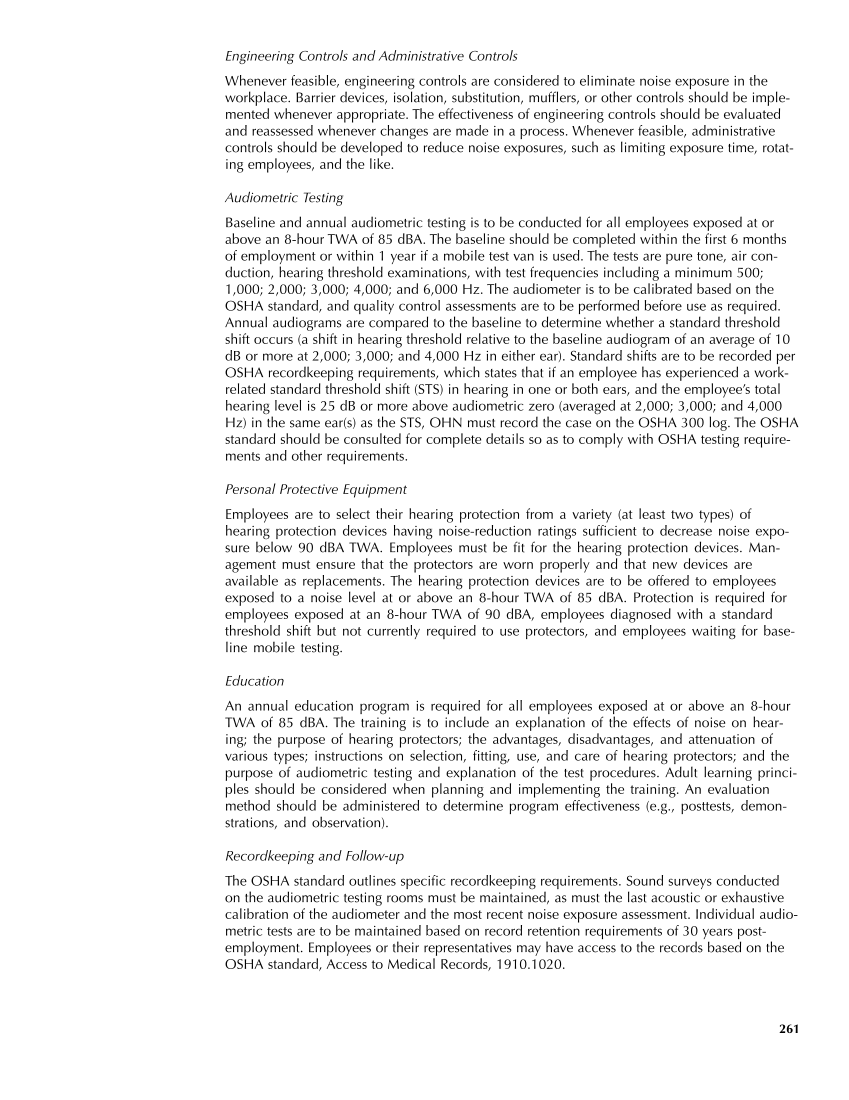Engineering Controls and Administrative Controls Whenever feasible, engineering controls are considered to eliminate noise exposure in the workplace. Barrier devices, isolation, substitution, mufflers, or other controls should be imple- mented whenever appropriate. The effectiveness of engineering controls should be evaluated and reassessed whenever changes are made in a process. Whenever feasible, administrative controls should be developed to reduce noise exposures, such as limiting exposure time, rotat- ing employees, and the like. Audiometric Testing Baseline and annual audiometric testing is to be conducted for all employees exposed at or above an 8-hour TWA of 85 dBA. The baseline should be completed within the first 6 months of employment or within 1 year if a mobile test van is used. The tests are pure tone, air con- duction, hearing threshold examinations, with test frequencies including a minimum 500 1,000 2,000 3,000 4,000 and 6,000 Hz. The audiometer is to be calibrated based on the OSHA standard, and quality control assessments are to be performed before use as required. Annual audiograms are compared to the baseline to determine whether a standard threshold shift occurs (a shift in hearing threshold relative to the baseline audiogram of an average of 10 dB or more at 2,000 3,000 and 4,000 Hz in either ear). Standard shifts are to be recorded per OSHA recordkeeping requirements, which states that if an employee has experienced a work- related standard threshold shift (STS) in hearing in one or both ears, and the employee’s total hearing level is 25 dB or more above audiometric zero (averaged at 2,000 3,000 and 4,000 Hz) in the same ear(s) as the STS, OHN must record the case on the OSHA 300 log. The OSHA standard should be consulted for complete details so as to comply with OSHA testing require- ments and other requirements. Personal Protective Equipment Employees are to select their hearing protection from a variety (at least two types) of hearing protection devices having noise-reduction ratings sufficient to decrease noise expo- sure below 90 dBA TWA. Employees must be fit for the hearing protection devices. Man- agement must ensure that the protectors are worn properly and that new devices are available as replacements. The hearing protection devices are to be offered to employees exposed to a noise level at or above an 8-hour TWA of 85 dBA. Protection is required for employees exposed at an 8-hour TWA of 90 dBA, employees diagnosed with a standard threshold shift but not currently required to use protectors, and employees waiting for base- line mobile testing. Education An annual education program is required for all employees exposed at or above an 8-hour TWA of 85 dBA. The training is to include an explanation of the effects of noise on hear- ing the purpose of hearing protectors the advantages, disadvantages, and attenuation of various types instructions on selection, fitting, use, and care of hearing protectors and the purpose of audiometric testing and explanation of the test procedures. Adult learning princi- ples should be considered when planning and implementing the training. An evaluation method should be administered to determine program effectiveness (e.g., posttests, demon- strations, and observation). Recordkeeping and Follow-up The OSHA standard outlines specific recordkeeping requirements. Sound surveys conducted on the audiometric testing rooms must be maintained, as must the last acoustic or exhaustive calibration of the audiometer and the most recent noise exposure assessment. Individual audio- metric tests are to be maintained based on record retention requirements of 30 years post- employment. Employees or their representatives may have access to the records based on the OSHA standard, Access to Medical Records, 1910.1020. 261
Purchased from OEM Press by (ge corporate access). (C) 2013 OEM Health Information, Inc. All rights reserved.












































































































































































































































































































































































































































